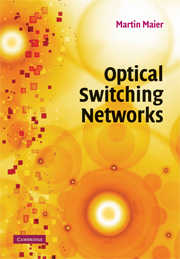Book contents
- Frontmatter
- Contents
- List of illustrations
- List of tables
- Preface
- Acknowledgments
- Part I Introduction
- Part II Optical wide area networks
- Part III Optical metropolitan area networks
- Part IV Optical access and local area networks
- Part V Testbeds
- 19 What worked and what didn't
- 20 Testbed activities
- 21 Summary
- Bibliography
- Index
19 - What worked and what didn't
from Part V - Testbeds
Published online by Cambridge University Press: 10 May 2010
- Frontmatter
- Contents
- List of illustrations
- List of tables
- Preface
- Acknowledgments
- Part I Introduction
- Part II Optical wide area networks
- Part III Optical metropolitan area networks
- Part IV Optical access and local area networks
- Part V Testbeds
- 19 What worked and what didn't
- 20 Testbed activities
- 21 Summary
- Bibliography
- Index
Summary
A variety of optical networking technologies and architectures have been developed and examined over the past decades. Up to date, however, only a few of them led to commercial adoption and revenue generation. According to Ramaswami (2006), Erbium doped fiber amplifiers (EDFAs), reconfigurable optical add-drop multiplexers (ROADMs), wavelength cross-connects (WXCs), and tunable lasers are good examples of devices successfully deployed in today's optical networks. In contrast, other technologies and techniques such as wavelength conversion, optical code division multiple access (OCDMA), optical packet switching (OPS), and optical burst switching (OBS) face significant challenges toward widespread deployment.
Crucial to the commercial success of any proposed networking technology and architecture is not only its performance evaluation by means of analysis or simulation but also a thorough feasibility study of its practical aspects. Toward this end, proof-of-concept demonstrators, testbeds, and field trials play a key role.
In this part, we provide an up-to-date survey of testbed activities on the latest switching techniques proposed for next-generation optical networks. A number of different optical switching techniques have been studied over the last few years. In our survey, we outline current testbed activities of the following major optical switching techniques: generalized multiprotocol label switching (GMPLS), waveband switching (WBS), photonic slot routing (PSR), optical flowswitching (OFS), optical burst switching (OBS), and optical packet switching (OPS), which were explained at length in previous chapters. We note that our survey is targeted to networks rather than stand-alone components and devices. Furthermore, we note that regional overviews of optical networking testbeds in Europe and China were recently reported in Fabianek (2006) and Lin and Wu (2006), respectively.
- Type
- Chapter
- Information
- Optical Switching Networks , pp. 273Publisher: Cambridge University PressPrint publication year: 2008



